| Apr-18-13 | | dumbgai: Great stuff from Moro. 51...g4 just loses the pawn, but there's not much black can do. The rook on f6 is stuck and after white plays e5 the weakness on c6 will fall as well. |
|
Apr-18-13
 | | HeMateMe: Moro just strangled him. After 54. Rxg4, should black play on a bit, and hope for counterplay? |
|
| Apr-18-13 | | Eyal: After Rxg4 the rook would return to f4 and then e5 comes and it's completely hopeless for Black. Most likely an immediate 53.e5 was enough to win anyway after 53...Nxe5 54.dxe5 Rxe5 55.Nh4 Rxf1 56.Bxf1 Rxh5 57.Rxc6, but the way Moro prepares it is even more decisive. I suppose 51...g4 was a sort of desperate attempt aimed against White's own g4 to prepare e5 (by supporting the knight). |
|
| Apr-18-13 | | messachess: Black is just too completely on the defensive at the end. Aaagh! what a position. |
|
| Apr-18-13 | | twinlark: This doesn't strike as a typical Morozevich game. Running this game through the abacus, Kasimdzhanov didn't make any real mistakes until maybe the queen exchange, he just drifted into an increasingly worse position from a position of complete equality. It's fascinating to see Morozevich patiently tightening his grip, more like Petrosian than the fire breathing iconoclast. I was wondering why Black exchanged queens mobilising the White pawns that ended up killing him, and removing his most manoevrable piece from the board in such a cramped position. But it was a truly horridly defensive position, and it seems White could have mobilised his pawns anyway. Strange that Black didn't want his queen by his side when that happened. The critical position seems to be at <45. R5c3>: 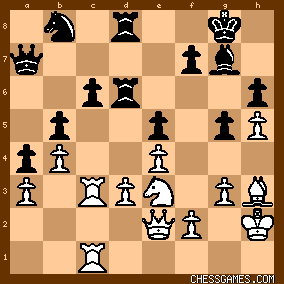
click for larger viewHere Black played <45...Rf6> which seems to add to the force of White's next couple of moves and the mobilisation of the pawns starting with <50. d4>. But 45...Rf6 moves off the d-file, undoubles the rooks, and blocks the action of the DSB, taking all the pressure off the d4 square. The engine recommendation of 45...Bh8 seems less like an engine move and more like a logical human possibility, as the lines of communication between the black pieces remains intact, the DSB is not attacked by any Nf5 move, and Black maintains pressure on the critical d4 square. A sample line I found on the abacus <45...Bh8 46. Nf5 Re6> and White will have a lot of trouble making headway. The engine has no idea how White can proceed with all the main lines flatlining into a piece shuffle of queens and kings on both sides (eg: <47. Qe3 Qc7>). One attempt after <45...Bh8 46. Nf5 Re6 47. Qe3 Qc7> might be the reasonably forcing line of <48. f4 exf4 49. gxf4 Nd7 50. fxg5 Nxc5 51. Rxc5 Qc7+ 52. Kg2 hxg5 53. Qxg5+ Kf8 54. d4> 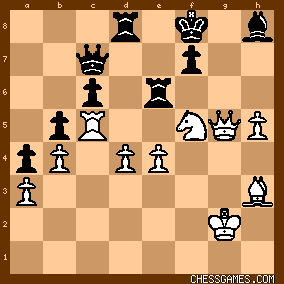
click for larger viewand White seems to have a lot going for him in return for the exchange. Black's simplest course might be to return the exchange and try for a BOC ending with <54...Rf6 55.e5 Rxf5 56. Bxf5 Rxd4>: 
click for larger viewIt's a complicated game, and these are just some preliminary analyses. Anyone see anything more for White from the first diagrammed position after Black plays <45...Bh8>? |
|
| Apr-18-13 | | twinlark: In the variation leading up to the second diagram, the counter-intuitive capture with the pawn on c5 might win, eg: <51. bxc5>. The pawn takes away that wonderful square for White's pieces, but it connects with the central pawns into a deadly force:
click for larger viewIf now <51...Be5 52. Rf1 (52.d4?? Bf4  ) hxg5 53. Qxg5 Kh8 54. d4> wins: ) hxg5 53. Qxg5 Kh8 54. d4> wins: 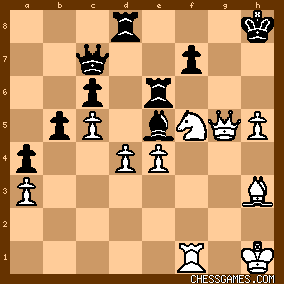
click for larger vieweg: <54...Rg8 55. Qe3> should win easily. So I guess backtracking is needed back to the first diagram in my last post and after <45...Bh8 46. Nf5 Re6 47. Qe3>: 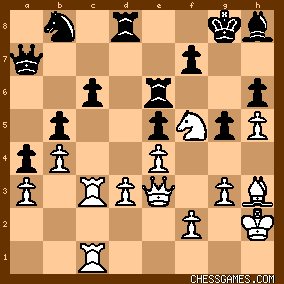
click for larger viewand now instead of checking with the queen, this is the time for the queen exchange with <47...Qxe3 48. fxe3 Kh7>: 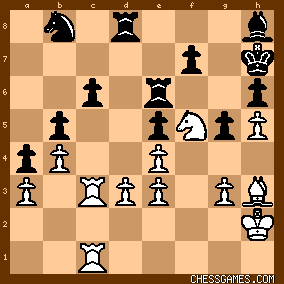
click for larger viewWhite has no good discovery and the onus is on him to break through, while defending his own weakness on d3. f4 is now impossible, and d4 will be extremely difficult |
|
| Apr-18-13 | | torreAC: moro started well... hope he lasts till end...well done |
|
| Apr-19-13 | | Eyal: <twinlark> I think the line you've posted got confused somewhere - 45...Bh8 46. Nf5 Re6 47. Qe3 Qc7 48. f4 exf4 49. gxf4 Nd7 50. fxg5 etc. doesn't make much sense because Black would rather play 49...Bxc3, and besides 50.fxg5 is illegal due to the pin by the black queen on the diagonal. |
|
| Apr-19-13 | | Eyal: <Kasimdzhanov didn't make any real mistakes until maybe the queen exchange, he just drifted into an increasingly worse position from a position of complete equality.> Trying to pinpoint moves where he made earlier mistakes, one is probably 19...Ra8 - instead he should have played 19...axb3 20.axb3 and only then 20...Ra8; this way he might both get some counterplay on the open file and meet an eventual b4 with Na4, making it considerably more difficult for White to make an effective break with the c-pawn than in the game because of the pressure the knight puts on c3. 22.Ng5! removes the black knight from e6 before opening up the position with 23.c4, so that it won't exert influence over d4 - so in hindsight, perhaps a better idea than 21...Rad8 would have been 21...Nd7, to support that knight on e6 with 22.Ng5 Ndf8. |
|
| Apr-19-13 | | Eyal: Btw, looking now at the round report on the official site (http://zug2013.fide.com/en/main-pag...) I see that in the press conference after the game Kasimdzhanov also pointed to 19...Ra8 (instead of axb3) as a serious mistake; Moro already criticized 14...d4 (instead of dxe4). |
|
| Apr-19-13 | | dTal: What happens after 44. ... Rxd3 instead of 44. ... Qa7 ? |
|
| Apr-19-13 | | Nerwal: 44... ♖xd3 45. ♘d5  |
|
| Apr-19-13 | | dTal: Thanks Nerwal, simple tactic that I just couldn't see. |
|
| Apr-19-13 | | twinlark: <Eyal: <twinlark> I think the line you've posted got confused somewhere - 45...Bh8 46. Nf5 Re6 47. Qe3 Qc7 48. f4 exf4 49. gxf4 Nd7 50. fxg5 etc. doesn't make much sense because Black would rather play 49...Bxc3, and besides 50.fxg5 is illegal due to the pin by the black queen on the diagonal.> It's annoying making that sort of mistake as it kind of ruins the whole analysis. You're quite right, I left out <48. Rc5 Qb6> in that variation, <then> followed by <48. f4> etc. |
|
| Apr-23-13 | | Ulhumbrus: 4...Bxf3 concedes the bishop pair. Black will be in trouble if he does not manage to either reduce its value or else gain compensation for it. |
|
| Apr-25-13 | | John Abraham: Absolutely brilliant and fantastic game |
|





